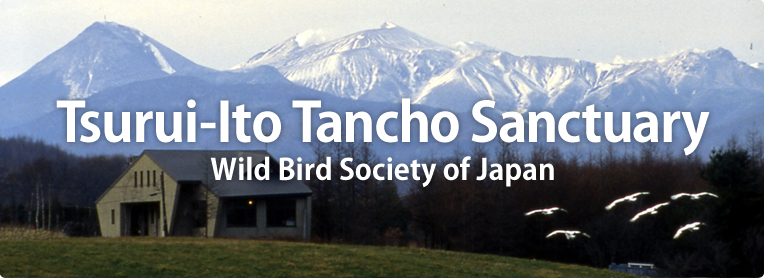
Most people who visit Tsurui-Ito Tancho Sanctuary are there to see or photograph red-crowned cranes. Tancho is the Japanese name for these magnificent birds. The viewing area is open to public at any time throughout the year; however, cranes rarely come near the viewing area from April to October. The best time to see the cranes at the sanctuary is from late November to mid-March. Feeding starts sometime in mid- to late November and continues until late March.
Tsurui-Ito Tancho Sanctuary was established by Wild Bird Society of Japan (WBSJ) in 1987. For effective conservation of red-crowned cranes and their habitat in Japan, a working group made up of specialists from conservation organizations and ornithologists in Japan and from overseas was formed in 1986. The working group made a recommendation to establish a sanctuary in the Village of Tsurui in eastern Hokkaido. Yoshitaka ITO,dairy farmer, had been one of designated care givers for the cranes and feeding them, and Mr. ITO agreed to establish the sanctuary on his property. Establishment of the sanctuary was made possible by contribution from WBSJ and donations from other donors around the world.
The Village of Tsurui is located near Kushiro Wetland, the largest wetland remaining in Japan, and the north-western portion of the wetland is within the municipal boundary of the village. Dairy is the main industry in the region, and, aside from the wetland, the landscape is dominated by pastures dotted with dairy farms and hills covered in trees. The sanctuary is about 50 minute drive from Kushiro Tancho Airport and about 1 hour by bus from Kushiro, the nearest city.
The sanctuary has an area of about 13 ha, and it is used as a way field in summer. North and east sides of the sanctuary is bordered by Setsuri River with the riparian woodland of Japanese oak (Quercus mongolica ver. crispula), willows (Salix spp.) and other species of trees and shrubs. There is a dairy farm to the south, and the residential area of the village is located to the west.
In winter, a portion of the pasture is used as the feeding station for the cranes. During the peak season, more than 300 cranes may be seen at one time. Visitors can see cranes up close across the wooden fence. There is no shelter at the viewing area, but there is public toilet. It is about 20 minute walk from the nearest bus stop and the convenience store.
There is the nature center overlooking the feeding station. The nature center has a heated observation room with spotting scopes and binoculars. During business hours, rangers provide information about the cranes and sanctuary. Hot drinks are available with a 100 yen donation. Original products of WBSJ which feature cranes and other birds can be purchased at the nature center.
| Nature Center | |
| Open seasons: | October-March. |
| Business hours: | 9:00-16:00 |
| Closed: | on Tuesdays & Wednesdays (except on national holidays) between December 26 and January 1 between April 1 and September 30 |
| Admission: | Free |
| Address: | Aza Nakasetsuri Minami, Tsurui-mura , Akan-gun, Hokkaido 085-1205 Japan |
| Phone: | 0154-64-2620 |
| Fax: | 0154-64-2239 |
| E-mail: | [email protected] |
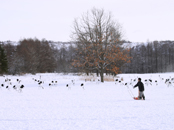 |
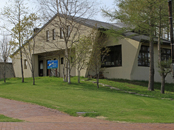 |
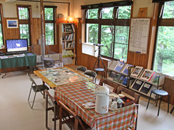 |
| The feeding ground in winter and Red-crowned Cranes | The Nature Center | Interior view of the Nature Center |
(1) |
Establishing nature reserves: In order to safeguard the breeding habitat of the cranes, WBSJ purchases properties with known nesting sites or secures agreements with landholders. These reserves are located outside of the boundary of areas protected by the government (such as national parks or wildlife refuges). As of April 2019, there are 24 WBSJ reserves with the total area of 2930 ha in eastern Hokkaido, and 33 pairs of red-crowned cranes are known to breed in these reserves. |
|
(2) |
Restoration of habitat for nesting: Rangers patrol the reserves and carry out maintenance. Some areas within the reserves had become alder woodlands which were thought to be unsuitable for nesting by cranes. After removing alder trees, one pair of cranes have returned to breed. |
|
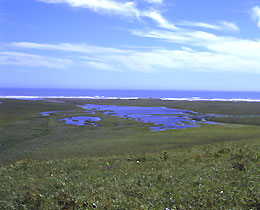 |
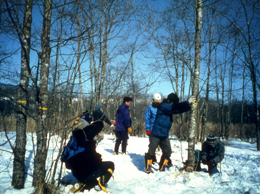 |
|
| The Watanabe Wild Bird Protective Area Fureshima with an area of about 204ha (Nemuro City, Hokkaido) | Cutting down alders to restore the wetland environment | |
(1) |
Managing habitat: In winter, most parts of eastern Hokkaido are covered in snow and ice. However, the cranes were able to survive in and around Kushiro Wetland because there are some ice-free streams fed by springs. Some of the ice-free streams have become inaccessible by cranes due to trees growing over them. To facilitate use of these habitats for foraging in winter, the rangers and volunteers remove trees in summer. |
|
(2) |
Feeding: From November to March, corn grown for livestock is provided to the cranes at the sanctuary. Feeding of the cranes has been continuing since 1950s. |
|
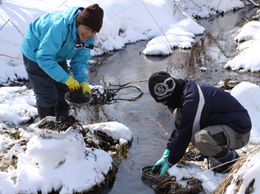 |
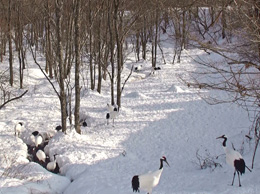 |
|
| Creation of the Red-crowned Cranes' natural feeding grounds in winter by volunteers | Red-crowned Cranes using the riversides environmentally maintained | |
(1) |
Away from the feeding station: There is still much to be learned about the foraging habitat of cranes in winter. Camera traps are used to understand how cranes are using the managed areas for foraging in winter. These cameras take a photo every 5 minutes automatically. During summer months, rangers spend many hours checking thousands of photographs for cranes. |
|
(2) |
At the feeding station: The number of corn eaten by a crane in one day has been quantified. Also, the number of cranes visiting the feeding station is monitored every day. These data will provide information about cranes’ dependence on feeding at the sanctuary. |
|
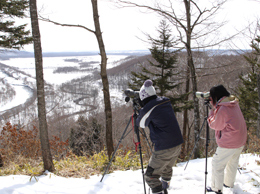 |
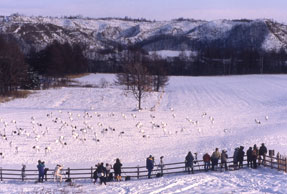 |
|
| Research to find the Cranes' natural feeding grounds in winter in Tsuruimura Village | Research on living things to be eaten by Red-crowned Crane in winter | |
(1) |
Tancho Teachers’ Guide: It is a collection of environmental education programs produced by WBSJ. It is designed to introduce morphology and ecology of red-crowned cranes as well as issues related to conservation of wetlands. Each program is a game, and the programs come with varying degrees of complexity to cater for different age groups of students from kindergarten upwards. It can also be used to increase understanding about the cranes and their habitat among adults such as teachers and nature guides. The rangers provide school visits as well as workshops for adults. It is hoped that through these activities, more people will become interested in cranes and their habitat. |
|
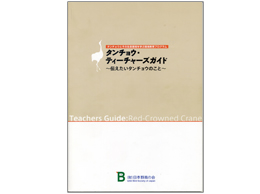 |
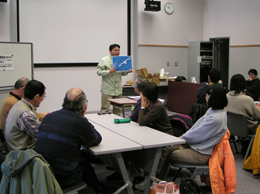 |
|
| Tancho Teachers' Guide | A lecture using Tancho Teachers' Guide | |
(2) |
Work camps and field days for volunteers: Every summer, students from local schools, employees of Japan Airlines (which features the crane emblem on their aeroplanes), and people from local businesses join the rangers on field days to maintain the foraging habitat of the cranes. University students, mostly from Tokyo metropolitan area, come to the sanctuary every summer and winter to help the rangers with research and extension. |
(3) |
When the nature center is open, the rangers are always happy to entertain visitors. Using various ‘toys’, the rangers will help visitors become familiar with biology of the cranes. WBSJ also collaborates with primary and secondary schools in easten Hokkaido to host annual exhibitions of illustrations of Red-crowned cranes drawn by students. At the nature center, there are some things to be learned about the cranes for everyone. |
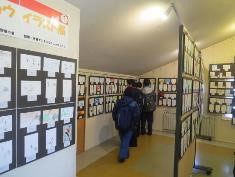 |
| Illustration of Red-crowned Cranes written by elementary and junior high school students. |
It is a non-profit organization founded in 1934. There are 86 chapters throughout Japan, with more than 30,000 members. Its core activities are conservation of birds and their habitat, carrying out research on the status of birds and their habitat, and encouraging more people to enjoy bird watching.